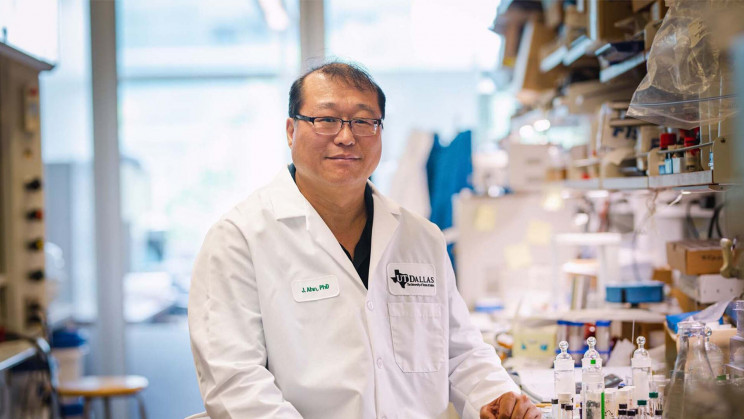
Scientists Discover A New Molecule That Kills Even The Deadliest Cancer
Recently, a tiny group of people with rectal cancer saw their disease vanish after experimental treatment.
It was a very small trial done by doctors at New York’s Memorial Sloan Kettering Cancer Center, wherein the patients took a drug called dostarlimab for six months. At the end of their trial, every single one of their tumors disappeared.
Now, in another breakthrough, a new compound synthesized by Dr. Jung-Mo Ahn, a University of Texas at Dallas researcher, has been found to kill a broad spectrum of hard-to-treat cancers, including triple-negative breast cancer, leaving healthy cells unscathed.
He exploited a weakness in cells that were hitherto not targeted by the other drugs.
The study, which was carried out in isolated cells, both in human cancer tissue and in human cancers grown in mice, was published in the journal Nature Cancer.
Only a few options for patients with triple-negative breast cancer
Ahn, a co-corresponding author of the study and a UT Dallas associate professor of chemistry and biochemistry in the School of Natural Sciences and Mathematics, has been working on small molecules that target protein-protein interactions in cells for more than a decade. Previously, he had developed potential therapeutic candidate compounds for treatment-resistant breast cancer and prostate cancer.
In his current research, Ahn and his colleagues tested a new compound he synthesized called ERX-41 for its effects on breast cancer cells – those that contained estrogen receptors (ERs) and those that do not.
Now, there are effective treatments for patients with ER-positive breast cancer, but only a few treatment options for patients with triple-negative breast cancer (TNBC) exist. It lacks receptors for estrogen, progesterone, and human epidermal growth factor 2. TNBC is known to affect women under 40 and has worse outcomes than other types of breast cancer.
“The ERX-41 compound did not kill healthy cells, but it wiped out tumor cells regardless of whether the cancer cells had estrogen receptors,” Ahn said. “In fact, it killed the triple-negative breast cancer cells better than it killed the ER-positive cells.
“This was puzzling to us at the time. We knew it must be targeting something other than estrogen receptors in the TNBC cells, but we didn’t know what that was.”
Soon, the researchers discovered that ERX-41 binds to lysosomal acid lipase A (LIPA), a cellular protein. LIPA is found in a cell structure called the endoplasmic reticulum, an organelle that processes and folds proteins.
“For a tumor cell to grow quickly, it has to produce a lot of proteins, and this creates stress on the endoplasmic reticulum,” Ahn said. “Cancer cells significantly overproduce LIPA, much more so than healthy cells. By binding to LIPA, ERX-41 jams the protein processing in the endoplasmic reticulum, which becomes bloated, leading to cell death.”
The team tested the molecule in healthy mice and noted that there were no ill effects.
“It took us several years to chase down exactly which protein was being affected by ERX-41. That was the hard part. We chased many dead ends, but we did not give up,” Ahn said.
“Triple-negative breast cancer is particularly insidious – it targets women at younger ages; it’s aggressive, and it’s treatment-resistant. I’m really glad we’ve discovered something that has the potential to make a significant difference for these patients,” Ahn said.
Can defeat the deadliest cancer
The researchers then fed the compound to mice with human forms of cancerous tumors, and they got smaller.
The molecule also killed cancer cells in human tissue that were gathered from patients who had their tumors removed.
There’s more.
They found that ERX-41 is effective against other cancer types with elevated endoplasmic reticulum stress, including hard-to-treat pancreatic and ovarian cancers and glioblastoma, the most ‘aggressive and lethal primary brain cancer’.
To investigate the ERX-41 molecule, Ahn worked with collaborators, including co-corresponding authors Dr. Ganesh Raj, professor of urology and pharmacology at the Harold C. Simmons Comprehensive Cancer Center at UT Southwestern Medical Center, as well as Dr. Ratna Vadlamudi, professor of obstetrics and gynecology at UT Health San Antonio. Dr. Tae-Kyung Lee, a former UTD research scientist in Ahn’s Bio-Organic/Medicinal Chemistry Lab, was also involved in synthesizing the compound.
Ahn is a joint holder of patents issued and pending on ERX-41 and related compounds, which have been licensed to the Dallas-based startup EtiraRX, a company co-founded in 2018 by Ahn, Raj, and Vadlamudi. The company has announced that it plans to begin clinical trials of ERX-41 as early as the first quarter of 2023, which offers the hope of effective new treatments.
Abstract: Triple-negative breast cancer (TNBC) has a poor clinical outcome, due to a lack of actionable therapeutic targets. Herein we define lysosomal acid lipase A (LIPA) as a viable molecular target in TNBC and identify a stereospecific small molecule (ERX-41) that binds LIPA. ERX-41 induces endoplasmic reticulum (ER) stress resulting in cell death, and this effect is on target as evidenced by specific LIPA mutations providing resistance.
Importantly, we demonstrate that ERX-41 activity is independent of LIPA lipase function but dependent on its ER localization. Mechanistically, ERX-41 binding of LIPA decreases the expression of multiple ER-resident proteins involved in protein folding.
This targeted vulnerability has a large therapeutic window, with no adverse effects either on normal mammary epithelial cells or in mice. Our study implicates a targeted strategy for solid tumors, including breast, brain, pancreatic and ovarian, whereby small, orally bioavailable molecules targeting LIPA block protein folding, induce ER stress, and result in tumor cell death.

